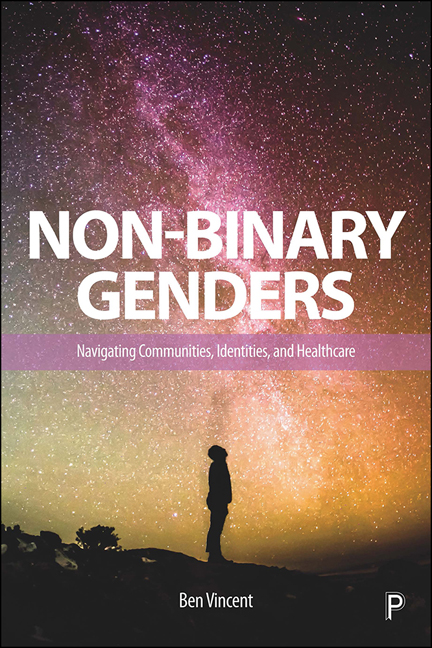Book contents
- Frontmatter
- Dedication
- Contents
- List of Figures and Tables
- Notes on the Author
- Acknowledgements
- Introduction
- 1 Reviewing Non-Binary: Where have we Come From?
- 2 Doing and Being: My Relationship with this Work, and how it was Done
- 3 ‘Not Trans Enough’: The Relationship Between Non-Binary Gender Identities, Uncertainty and Legitimacy
- 4 Non-Binary Times, Non-Binary Places: Communities and their Intersections
- 5 Views of the Clinic: Non-Binary Perceptions and Experiences of General Healthcare Services
- 6 A Strong Motivation to Tick The Boxes: Non-Binary Perceptions and Experiences of Gender Identity Clinics
- Conclusion
- References
- Index
Introduction
Published online by Cambridge University Press: 10 March 2021
- Frontmatter
- Dedication
- Contents
- List of Figures and Tables
- Notes on the Author
- Acknowledgements
- Introduction
- 1 Reviewing Non-Binary: Where have we Come From?
- 2 Doing and Being: My Relationship with this Work, and how it was Done
- 3 ‘Not Trans Enough’: The Relationship Between Non-Binary Gender Identities, Uncertainty and Legitimacy
- 4 Non-Binary Times, Non-Binary Places: Communities and their Intersections
- 5 Views of the Clinic: Non-Binary Perceptions and Experiences of General Healthcare Services
- 6 A Strong Motivation to Tick The Boxes: Non-Binary Perceptions and Experiences of Gender Identity Clinics
- Conclusion
- References
- Index
Summary
Voices from beyond the gender binary
Gender diverse people have been prompting questions about the nature of gender for as long as they have been recognised. In the 20th-century West at least, trans discourses have been heavily shaped by social/gendered expectations – disciplining not only the possibilities of embodiment and expression, but also identity. In 2002, Joan Nestle, Clare Howell and Riki Wilchins edited a collection comprised of Wilchins’ essays and short community pieces, titled Genderqueer: Voices from Beyond the Sexual Binary. This was remarkable not only because of its bottom-up centralisation of marginalised voices, but because of the very explicit nature of its central premise: individuals, whose genders are neither male nor female, exist.
In general public and academic contexts, such experiences of gender have been predominantly recognised (where they were at all) as historic and/or non-Western (Herdt, 1993). However, identities outside the gender binary have also been clearly articulated within modern Western contexts, long before non-binary emerged as an umbrella term (for example, Feinberg, 1996). Historians of gender and sexual minorities are commonly confronted with the issue of how we label figures who are positioned as part of queer history. Indeed, it was not only the striking androgyny of Schwartzenbach that inspired me to open this book with her picture, but the photographer Marianne Breslauer's beautiful words about her: ‘She was neither a man nor a woman, but an angel, an archangel’ (Julienne, 2018). While Schwartzenbach's love of women was known, we can also see a relatability to non-binary through her transgressive gender presentation and how she was seen by others – as captured by Breslauer's images and words. There is a shared history for anyone transgressive of ‘normal, proper’ gendered or sexual behaviour, whereby their status as men or women could have been symbolically or literally called into question (Trumbach, 1993). This history contributed to the codification of femininity and masculinity with non-heterosexual men and women respectively, even after the lay-conceptualisations of sexual orientation and gender identity had been disentangled.
Was Schwartzenbach non-binary? This is the wrong question to ask. The sexual and gender identities of people from the past cannot be unproblematically housed within newer identity categories, because such categories do more than simply describe who a person may desire, or their self-concept.
- Type
- Chapter
- Information
- Non-Binary GendersNavigating Communities, Identities, and Healthcare, pp. 1 - 18Publisher: Bristol University PressPrint publication year: 2020



